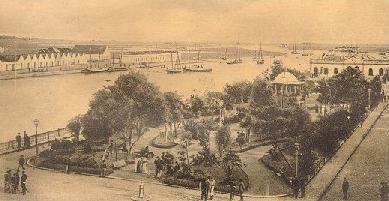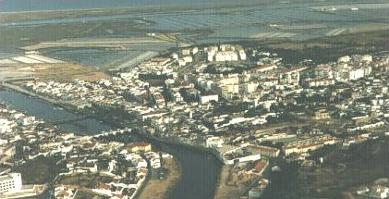|
Tavira |
| Portugal > Tourism > Algarve > Tavira > History |
| This area has been populated since the times of moslem domination. Before then, a busy roman road followed the coastline, connecting Baesuris (Castro Marim) to Ossonoba (Faro) crossing over the Gilão river at the bridge, bordering on the ancient region of the Balsa. During the last quarter of the 19th century, Estácio da Veiga discovered the Balsa roman ruins, in the Quinta das Antas and Torre de Aires, located along a coastal strip between Santa Luzia and Luz de Tavira. Stone instruments and copper weaponry were uncovered at the site excavations, indicating possible settlements before roman times. Neolithical traces were found; the name Quinta das Antas supports these findings. Even the non-latin name Balsa points to its protohistorical origins.Lacking solid evidence for earlier settlements by Turdetanos or Turdulos, it is possible that Balsa was Phoenician or Carthaginean when the Romans arrived. |
| During the domination of Barbarian peoples, after the fall of the Western Roman Empire (late 5th century until the moslem invasion of the Iberian Peninsula), no documentation about this region exists. All we know is that in 712, a year after Tarique invaded the Peninsula, Abde Alaziz conquered Beja and the Algarve; this Algarve, or "Al Garb Andaluz" (Western Andalusia) covered a vast territory from west to northeast of the Guadiana river. As the moslems gradually lost the |
|
 |
| domination of this area, the Algarve achieved its present day boundaries. The first news about Tavira date to the 11th century and refer to port activity. In mid-11th century, Tabira (Tavira) was one of the main settlements of the Al Garb, as were Santa Maria al Harum (Faro) and Silb (Silves). In the 12th century battles between Almorávidas and Almóadas led to the submission of Tavira to the Almunine Emir, in 1168. In the "Roteiro a partir de Saltes", relative to the Al Garb in the early 12th century, the arab geographer Edrici places Tabira between Cacela and Santa Maria do Garb (Faro); Balsa is no longer mentioned. However, the roman bridge over the river at Tavira is an indication that moslem settlements continued in the region after the romans. This raises the question of when these settlements were started and how they relate to the Balsa; a polemical question waiting for a convincing answer. Equally unknown is the exact origin of the name Tavira, also referred to as Tabira or Tavila in ancient documents. |
| During the christian reconquest, Portugal was founded and southward territorial expansion began; the crossing into the southern Alentejo started in 1238. The study of the Conquest Chronicles of the Algarve indicates that Tavira is taken from the moors in 1242 by D. Paio Peres Correia as a reprisal for the treacherous murder of 7 of his knights while hunting near the settlement. Two years later Tavira was donated by D. Sancho II to the holy order of Santiago. In accordance with the perceived importance of the settlement, D. Afonso III distinguished it with a town charter in 1266 as well as other Algarve fortresses (Faro, Loulé and Silves). The importance of Tavira resulted ever then from its privilleged port location, which is confirmed in 1282 by D. Dinis, when he bestows rights and privileges on the alcaide and seamen of Tavira equal to those of Lisbon. During the initial portuguese expansion period, particularly after positions were established in Northern Africa, the location of Tavira`s port, the closest to the Moroccan coast, became a vital player in supporting the african positions and reducing piracy from the Cape of S. Vincente to the Straits of Gibraltar. Tavira`s importance until the end of the 16th century was further reinforced and maintained by traditional fishing activity associated with maritime trade based on salted fish exports, as well as dried fruits (almonds, figs), wine and other products, reaching distant ports of Italy and Flanders. From June to September of 1489 D. João II stayed in Tavira, and it was raised to Town level by D. Manuel in 1520. |
| During the first quarter of the 17th century, Tavira is still known as the "most important (town) in the Algarve", although documents from earlier years reveal symptoms of decline. In the meantime, the progressive withdrawal from african conquests had taken place as well as the loss of independence. Seville and other ports in southern Spain were now the ports of arrival for the Indian (western) routes, concentrating wealth and trade. |
|
 |
| The effects of a devastating plague (1645-6) associated with the long Restoration campaign, further exarcebated with the silting of the harbor, played a major role towards Tavira`s loss of importance, at the end of the 17th century. During the 18th century, the port was used almost exclusively for fishing and coasting activities, the latter reduced to nearby destinations; the outside dependance became evident. The 1755 earthquake, although less damaging than in other regions of the country, contributed to this bleak scenario. The Marquis de Pombal founded a tapestry factory (1766) in Tavira, as part of his national recovery policy, although its existence and production were short-lived. During the D. Maria I reign, ample military barracks were built at the end of the 18th century on the outskirts of the town at the ancient Atalainha site. During the civil war period, in 1833, a liberal expedition headed by the duke of Terceira that set out from Oporto, landed on a beach just outside Tavira and started its march towards Lisbon, ultimately overthrowing D. Miguel`s troops. The economic activity of the town and port, closely related to fishing, was significantly affected during the second part of this century as the tunny fish shoals moved to other areas. Four of the five tuna spots of the Algarve had been around Tavira: Abóbora, Medo das Cascas, Barril and Nova; the other, Cabo, was in Faro. Presently, the town lacking in productive structures and trying to surpass centuries of decline, the development of natural and cultural tourist activities appear as an viable alternative. The historical evolution of Tavira is visible evidence of a greater national whole, and not an isolated case. Concerning its appearance, and excluding the devastating effects of several earthquakes and recent buildings, Tavira as a whole maintains the look inherited from ancient times; a visibly medieval center, surrounded by another town with many details and shapes pointing to distant times. The signs and symbols of a remarkable historical past, a cultural heritage that should be defended and preserved. (For more information - www.arqueotavira.com) |
| Portugal > Tourism > Algarve > Tavira > History |
|
History |